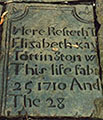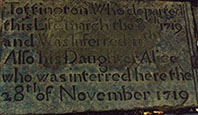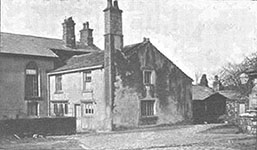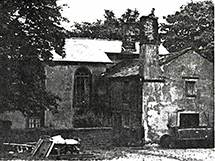The Ancestry of John Kay
Robert Kay of Park
Park Farm is in Walmersley; it is on the left hand side of the A56 going north out of Bury, opposite the garden centre and tea rooms. The tea rooms are a must if you are there, having won a competition with Gordon Ramsey. Robert bought the property in 1694 from Matthew Pinkerton of Pilkington for the sum of £240. John Lord’s Memoir includes a reproduction and transcript of the receipt for the second half of the payment; the property was then known as ‘Rothwells of the Parke‘, while Robert was described as ‘Robert Kay of Sheephey in Walmersley, husbandman‘ [JL]. A Final Concord was executed on 6th August 1695 where the property was described as ‘28 acres of land 4 acres of meadow 8 acres of pasture and common‘ [JL].
Robert’s will was dated 27th March 1704 and proved on 27th May of the same year; the inventory was dated 18th April 1704, so we have a very clear idea of when he died [LCRO*]. Executors were his wife Ellin and brother in law William Entwistle, and he named his children Robert, Ephraim, Richard and William (all were under 21 at the time, and the last two were under 18). At the time of writing, his wife was pregnant and provision was made in the will for the child, should he or she survive – this was our John.
Elizabeth Kay of Lowe
The central document when researching John Kay’s ancestry is the will of Elizabeth Kay of Lowe [LCRO*]. Dated 1st April 1708, it was proved 21st May 1711; the inventory of her possessions was made 3rd March 1710/11. In it she named her children:
- Richard Kay of Sheephey (late son), his wife Alice and his children Robert Kay, Thomas Kay, Oliver Kay, Edward Kay, Elizabeth Hamer and Mary Kay
- Robert Kay of Park (late son), and his children Robert Kay, Richard Kay, William Kay and John (all of them minors)
- James Kay of Shipperbottom (late son) and his childen Robert Kay, Elizabeth Kay and Ann Kay (see note)
- Oliver Kay (still alive) and his children Robert Kay, Oliver Kay and Alice Kay
- Elizabeth Marcroft (still living) and her children Abraham Leach, Elizabeth Hamer and Daniel Leach
- Alice Kay of Cross Hall (late daughter) and her children Richard Kay, Robert Kay, John Kay and Mary Kay
- Margaret Holt of Catloe Lane (late daughter) and her son Robert Holt
Clearly, this is the will of Robert of Park’s mother (see note); equally clearly, although she died at Lowe in Tottington, she was a Sheephey Kay.
Elizabeth’s daughter Alice was the second wife of Richard Kay of Baldingstone (1628/9-1697/8) and her will has survived (dated 10th Sep 1707, proved 14th Jun 1711, with the inventory made 28th Jan 1707/8 [LCRO*]). She had inherited the tenancy of Cross Hall Farm from her husband, though it reverted to her sons Richard and Robert on her death. She too named her children Richard, Robert, John and Mary Kay. It was Alice’s grandson Richard Kay, the son of Robert, who kept a diary between 1737 and 1750, excerpts from which have been published by the Chetham Society; the original is now on permanent loan to the Chetham Library in Manchester. See our article The Diary of Richard Kay. Unfortunately for us, although there are several mentions of his Sheephey and Park cousins, there is none of John unless he was the ‘Coz. John Kay from Bury‘ who visited on 4th March 1743.
Alice’s son Richard also kept a diary, or rather a set of notebooks containing memoranda on financial and other matters. This was lost in the nineteenth century, but extensive extracts were made by Canon Raines and can be found among his papers in the Chetham Library. In it, he recorded:
| My grandmother died at Lowe Sunday 25 February 1710 |
which gives yet another proof of the relationships described above.
It was standard for wills of the period to list children in order of age, though sons usually appeared before daughters: this means the Robert was the second son – Richard had inherited the tenancy of Sheephey, Robert had moved away to Park. But it does beg the question of where Robert came by the money to buy Park. At the time, most property in Bury (including Sheephey) was leased from the Earls of Derby; for a Kay to own property was unusual, and £240 was a serious sum of money. Wills from the 17th century suggest that the Sheephey Kays were better off than most; they also suggest they did a lot of money-lending. The Baldingstone Kays were good at this too. At the time of his death in 1696/7, Richard of Baldingstone was owed £658 ‘upon bond whereof some desperate‘ and ‘upon Mortgage‘; ten years later Alice held mortgages to the value of £925 [LCRO*]. Research at the County Records Office in Preston has shown that Richard started life as a blacksmith, as was his father John before him; there is strong evidence that the family’s fortunes were made at the expense of Royalist supporters after the Civil War. Alice was his second wife, and nearly 20 years his junior. There is a story here which still needs researching.
An interesting side-note here is that parts of Elizabeth’s gravestone still survive. In the early 1900s, in a communication with Kenneth Kay (see note), John Lord recorded the following gravestone in the churchyard of St Mary Bury, the top right hand corner of which was missing as shown by the dots [KK]:
| Here Resteth The …. | |
| Elizabeth Kay … | |
| Tottington who … | |
| This Life Febryary | |
| 25 1710 And was interred | |
| The 28 | |
| Here resteth the Body of | |
| Oliver Kay of Lowe in | |
| Tottington who departed | |
| this Life march the 8th 1719 | |
| and Was Interred 11th | |
| Also his Daughter Alice | |
| who was interred here the | |
| 28th of November 1719 |
| Many of the gravestones from the churchyard are now used to pave the area around the church, and at the back of the church there used to be two fragments from Elizabeth’s. They’ve been moved now, and only one has survived, on the north side of the church. |  |
 |
Sheephey
 Sheephey Farm is in Shuttleworth, to the north of Walmersley; extensively rebuilt in 1998, there is still some trace of the original building. The first of the attached pictures is from John Lord’s Memoir; the second was taken sometime before 1978 by Geoffrey Ramsden during his researches into the Baldingstone Kays. Both give an idea of what it would have looked like, and show a substantial building.
Sheephey Farm is in Shuttleworth, to the north of Walmersley; extensively rebuilt in 1998, there is still some trace of the original building. The first of the attached pictures is from John Lord’s Memoir; the second was taken sometime before 1978 by Geoffrey Ramsden during his researches into the Baldingstone Kays. Both give an idea of what it would have looked like, and show a substantial building.
Those Sheephey Kays were a rough lot. Richard Kay of Sheephey appeared in the Tottington Court Rolls for 1509, having made an assault on Hugh Hartside in the Chapel at Holcombe; in the Clitheroe Court Rolls for 1538, a Richard Kaye of Sheepe Hey was concerned in an affray with Christopher Muttoo and in 1540 with Ellis Bridge [GR – verification needed]. Clitheroe may seem a bit far away for this reference to apply, but Tottington was in the honour of Clitheroe, so it is possible that this case was being tried in a higher court.
 Documents from the seventeenth century indicate that there were three families of Kays living at Sheephey – there are references to ‘Sheephey’, “Higher Sheephey” and ‘Lower Sheephey’. The 1666 Hearth Tax assessment listed two distinct households – ‘Jo Kay de Sheephey’ who was assessed for one hearth and ‘Rob Kay de Sheephey’ who was assessed for two [PRO*]. Our research has shown that Robert (the inventor’s grandfather) did indeed live at Sheep Hey Farm, pictured here. Higher and Lower Sheephey were to the east, on the opposite side of what is now the A56 – Higher Sheephey was later called Hollins (it can be found on the 1848 Ordnance Survey map) where Hollin Lane now is, and Lower Sheephey was to the south, towards Windy Bank.
Documents from the seventeenth century indicate that there were three families of Kays living at Sheephey – there are references to ‘Sheephey’, “Higher Sheephey” and ‘Lower Sheephey’. The 1666 Hearth Tax assessment listed two distinct households – ‘Jo Kay de Sheephey’ who was assessed for one hearth and ‘Rob Kay de Sheephey’ who was assessed for two [PRO*]. Our research has shown that Robert (the inventor’s grandfather) did indeed live at Sheep Hey Farm, pictured here. Higher and Lower Sheephey were to the east, on the opposite side of what is now the A56 – Higher Sheephey was later called Hollins (it can be found on the 1848 Ordnance Survey map) where Hollin Lane now is, and Lower Sheephey was to the south, towards Windy Bank.
Several wills and leases have survived from the period but it is not always easy to determine which family they refer to. The transcriptions of the registers of St Mary Bury, published by the Lancashire Parish Registers Society, have many references to Kays of Sheephey – too many in fact to get any definitive picture of relationships. These were clearly extended families with cousins living in the same farm, acting as servants or hired hands. For example, Richard Kay of Sheephey who died in 1646/7 had a servant called Robert Kay, and there were two other Richards at Sheephey who died in the 1630s. This is not an easy task!
For a full list of wills and leases relating to Sheephey, and a description of the life lease system used in Bury at the time, see Sheephey Wills and Leases. They reinforce what has already been stated, that there were three families at Sheephey, all financially affluent. The inventor’s family used the names Robert and Richard alternatively through the generations (a common practice at the time – all four of Elizabeth’s sons named their oldest son Robert), while the Higher and Lower Sheephey families used John and Thomas.
It is generally accepted that Elizabeth’s husband was named Robert, and there is evidence to support this:
- Robert Kay of Sheephey died 21st January 1668/9 [LPRS]. His will has not survived, but the inventory has; his widow Elizabeth was executor [LCRO*]
- There are records for the baptisms of three children of Robert Kay of Sheephey – Elizabeth (b 13th July 1648), Margaret (b 11th May 1653) and Oliver (b 23rd September 1667) [LPRS]. These match the names and order of birth of three of the children in Elizabeth’s will.
- Robert Kay of Sheephey took out a lease on 13th February 1663/4 for 27 acres and 3 roods. Lives on the lease were Robert, and his sons Richard and Robert (in that order) [LCRO*]
Andrew Todd, in an article on the Grimes of Scout [BCL] has shown that Elizabeth Kay was the daughter of Oliver Grime of Scout (in the north west of Shuttleworth); there were strong links between the Kays of Sheephey and the Grimes of Scout. The predeliction for the name Oliver among the Sheephey Kays (in her will, Elizabeth showed definite favouritism towards her son and grandson who bore the name) seems to have been an inheritance from the Grimes. As Mr Todd remarks, using the name Oliver in the years after the Restoration would have been equivalent to christening your child Adolph immediately after World War 2. This tells us a lot about the family’s political and religious views, and counters the often made assertion that the family were Jacobites and High Anglican (see note). The Baldingstone Kays were of the same conviction; a hundred years later, at the time of the 1745 rebellion, Richard Kay recorded in his diary a Jacobite pamphlet which described his family as ‘Oliverian Murderers’. ‘Times at present run high amongst us’ he wrote on the same day; they most certainly did [RKD*] (see note).
The pattern of names and dates showing in the attached wills and leases suggests strongly that we have two clear generations before Robert and Elizabeth, and tentatively another further back:
- Richard (died 1573): children Robert, Cateryn, Margaret and 4 other daughters
- One or two missing generations
- Robert (died 1637/8): children Richard and Robert
- Richard (died 1646/7): wife Alice, children Robert, James and Alice
This however needs further work, as do the Kays of Higher and Lower Sheephey.